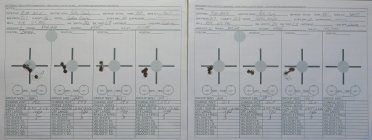Thanks RegionRat. I don't mind at all that you or anyone else will use the data as that's why I elected to show it as I did. The performance is better than I ever expected out of a factory RPR with a barrel upgrade.@Straightshooter1 , I was very impressed with your data. Not only with your discipline to collect and maintain your notes in such an organized fashion, but also with the results. The performance is exceptional.
I hope you don't mind me using a sample of your data to illustrate a point on the theme of prioritizing the target over the chrono. I plotted the SD versus your group size. What is shows is a R^2= 0.0592, and for those who don't speak statistics that is like saying no correlation at all.
Not to say don't use a chrono or pay attention. These data clearly show a meticulous disciplined loader at work, and a chrono is a form of Quality Control. It augments the target work, but doesn't trump it.
View attachment 1371057
Here is another example of a great performing load, giving nearly a factor of three dispersion in SD values, while keeping under 0.5 MOA.
Well done Straighshooter1.
I've used Excel ever since it first came out and always found it a very helpful tool in managing and analyzing my limited personal data of sorts. There's more to my data sheet that I posted and felt the rest might be a distraction to the point of the thread's heading. But, on second thought, I probably should have shown the whole thing; here's more of what all is on my data sheets for those who feel its needed:

, , , along with my most recent target result












